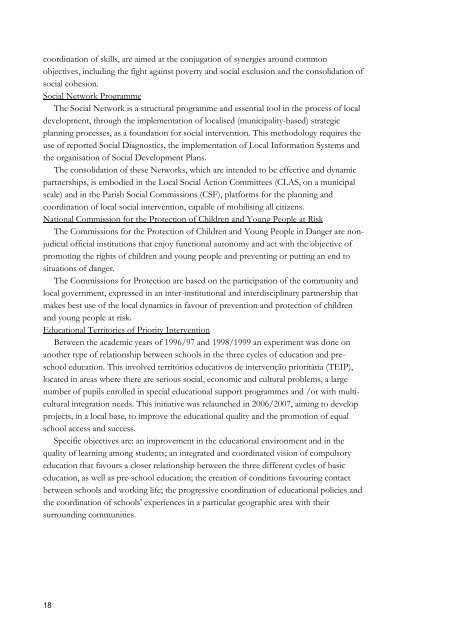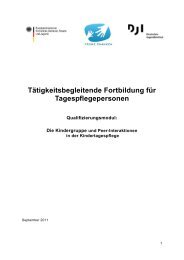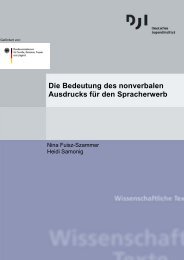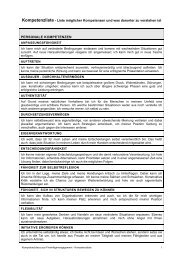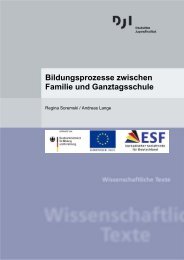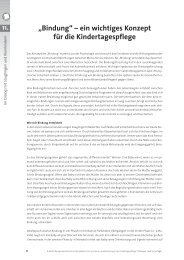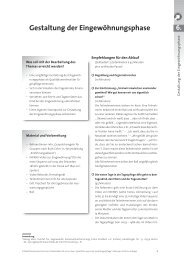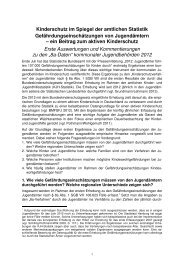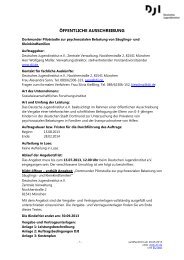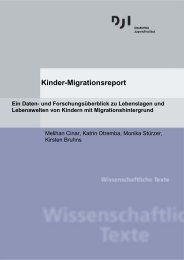download - Deutsches Jugendinstitut e.V.
download - Deutsches Jugendinstitut e.V.
download - Deutsches Jugendinstitut e.V.
Create successful ePaper yourself
Turn your PDF publications into a flip-book with our unique Google optimized e-Paper software.
coordination of skills, are aimed at the conjugation of synergies around common<br />
objectives, including the fight against poverty and social exclusion and the consolidation of<br />
social cohesion.<br />
Social Network Programme<br />
The Social Network is a structural programme and essential tool in the process of local<br />
development, through the implementation of localised (municipality-based) strategic<br />
planning processes, as a foundation for social intervention. This methodology requires the<br />
use of reported Social Diagnostics, the implementation of Local Information Systems and<br />
the organisation of Social Development Plans.<br />
The consolidation of these Networks, which are intended to be effective and dynamic<br />
partnerships, is embodied in the Local Social Action Committees (CLAS, on a municipal<br />
scale) and in the Parish Social Commissions (CSF), platforms for the planning and<br />
coordination of local social intervention, capable of mobilising all citizens.<br />
National Commission for the Protection of Children and Young People at Risk<br />
The Commissions for the Protection of Children and Young People in Danger are nonjudicial<br />
official institutions that enjoy functional autonomy and act with the objective of<br />
promoting the rights of children and young people and preventing or putting an end to<br />
situations of danger.<br />
The Commissions for Protection are based on the participation of the community and<br />
local government, expressed in an inter-institutional and interdisciplinary partnership that<br />
makes best use of the local dynamics in favour of prevention and protection of children<br />
and young people at risk.<br />
Educational Territories of Priority Intervention<br />
Between the academic years of 1996/97 and 1998/1999 an experiment was done on<br />
another type of relationship between schools in the three cycles of education and preschool<br />
education. This involved territórios educativos de intervenção prioritária (TEIP),<br />
located in areas where there are serious social, economic and cultural problems, a large<br />
number of pupils enrolled in special educational support programmes and /or with multicultural<br />
integration needs. This initiative was relaunched in 2006/2007, aiming to develop<br />
projects, in a local base, to improve the educational quality and the promotion of equal<br />
school access and success.<br />
Specific objectives are: an improvement in the educational environment and in the<br />
quality of learning among students; an integrated and coordinated vision of compulsory<br />
education that favours a closer relationship between the three different cycles of basic<br />
education, as well as pre-school education; the creation of conditions favouring contact<br />
between schools and working life; the progressive coordination of educational policies and<br />
the coordination of schools' experiences in a particular geographic area with their<br />
surrounding communities.<br />
18


